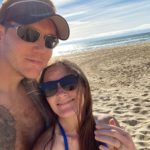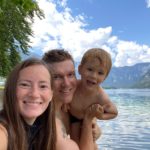My Bike Manual…
I just wanted to put some stuff down here on what I’ve learned so far about touring, biking, mountain biking, and the bikes I own. Sometimes if I go a few months without using one I forget what PSI should be in the tires…
General Biking Stuff
– If I do a pinch flat, take it out, check the tire and spokes, then put the tire back on, half inflate the tube, put it in and then pressure it up. Make sure the edges match and wheel in the right direction. This is more complicated than it sounds. I’ve seen it done twice now…
Body Position…
1. Keep your heels relatively flat, pushing through your heels not the balls of your feet. Every time you point the foot downwards to complete the full pedal revolution you lose power through the ankle. If you’re doing this there’s a good chance your saddle is too high.
2. Don’t rock left to right at the pelvis as this absorbs power. If you need to do this to complete the whole pedal movement your saddle is too high.
3. Keep your upper body relaxed and hold the handlebar hoods with arms bent through about 135 degrees so you can see the insides of your elbows, rather than with straight arms. This absorbs road buzz much better and prevents your body from taking a battering.
4. To do the above you need to engage your core muscles. While leaning forward, hands on the hoods, you should be able to switch hand position without moving your body. 75-80% of people don’t have a strong enough core to do this, but if you practice using this arm position you will have to engage it, and then you will find you have much more power to the legs, especially climbing.
5. When climbing, try to keep as straight as possible to avoid rocking from side to side and wasting power. The best way to do this is to engage your core and think about keeping your nose in line with the front wheel as much as you can. Do this and you’ll be amazed how much more power you can put down on the climbs.
Specific To My Tout Torrain Outback Xplore 29
Gear / Notes
- I have Jones H Bar (Loop Model (Not Bend)). The width is 710mm, Rise of 0.5, and SG Aluminum on the material.
- I can buy tape and tape these all over if I want.
- I have a pinion DS2 shifter.
- Cinq Carbon Adventure Fork
- Gates Carbon Drive – Plus an extra.
- Pinion P-Line 1.18
Maintenace
- Check to make sure the stem in alignment with front wheel, and secured where I can’t diff the two between my legs.
- Check that all the bolts on the bike are secure, esp with a lot of off-road (shake loose).
- Tension on the gate drive is going to be interesting… For internally geared hub, around 35 to 50HZ, ie 24 to 40lb.
- Manual has pictures to check when drive gear and sprockets are worn.
Specific Too My Touring Bike (Marrakesh)
– I need to always carry a tube with me on rides, just in case I pop it. Better yet two of them. I don’t think I’ll go tubeless with this for several reasons…
– For tires I am running GravelKing SK 700x38C, I still have the org in storage in case I want to switch. These are made for gravel riding.
– For tire pressure, they recommend a max of 60 PSI.
General Mountain Biking Stuff
– Going faster can help on the rough stuff, as opposed to slow.
– Drop the seat 2 to 3 in versus climbing, lowers your center of gravity and helps.
– Always yield to people going uphill.
– Do not use the front brake when you are starting.
– General guidelines on tire pressure for tubeless…
Too high: Higher tire pressures help support the sidewall of the tire offering increased stability and increased protection for the rim, but go too far and traction will be drastically reduced as the contact patch shrinks and the ride will feel harsh.
Too low: Low pressures increase grip from the larger contact patch and improve cornering traction as the softer tire can wrap around trail imperfections. However run the tires too low and you drastically increase the risk of rim damage from square edged hits, and the softer air pressure reduces the natural spring of the tire which can create a wallowy and unstable ride at speed. In hard turns, the tire tends to lack stability in the sidewall and can feel vague.
Getting your tyre pressures right is critical to having a good ride. Too low and you will have sloppy handling and heavy road feel; too high and you will be bumped around and uncomfortable while handling suffers. You also need to adjust your tyre pressure to the conditions: in winter, you should run lower pressures to improve grip on wet roads, whereas in summer slightly higher pressure means less rolling resistance and helps you cover longer distances more easily.









Recent Comments